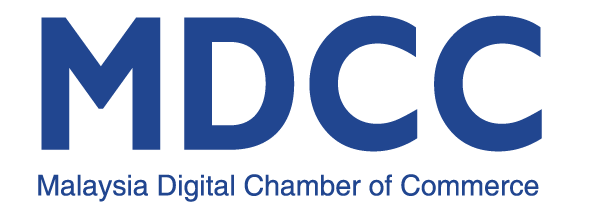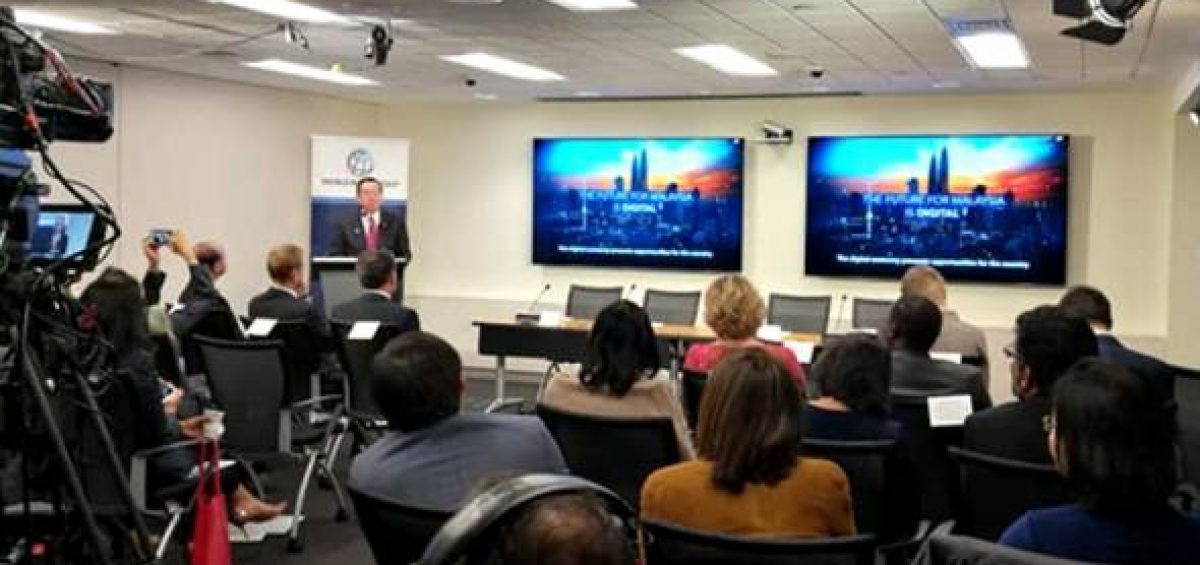INTRODUCTION
1. I would like to thank the World Bank Group for organizing this dialogue session on the digital economy as the new driver of growth. I am pleased to share Malaysia’s achievements on this front as well as our future initiatives here today
DIGITAL INFRASTRUCTURE IN MALAYSIA
2. As of 2018, Malaysia has a internet penetration rate of 85.7%. This fares very well in a region where the penetration rate hovers at approximately 60%.
3. We expect the national penetration rate to rise further as Malaysia improves its digital infrastructure to provide reliable and ultrafast broadband internet service, which is essential to unlocking the potentials of our digital economy. We have also launched the National Fiberisation and Connectivity Plan (NFCP) to spur the digital economy and accelerate the development of broadband infrastructure.
4. But Malaysia is not just focusing on the hard infrastructure. Upon coming to power last year, the new Government has reformed the national broadband service industry and made the market structure work better for the consumers. New policy was put in place to increase competition and drive down costs while providing faster internet speed for the population. The availability of affordable high-quality internet is enabling the rapid expansion of the digital economy, and contributes to creating an inclusive high-quality growth for all Malaysians.
DIGITALISATION OF GOVERNMENT SERVICES
5. The Malaysian digital economy on average had grown 9% annually in value-added terms between 2010 to 2016. This is faster than Malaysia’s overall GDP growth, highlighting its role as a source of expansion. Furthermore, the International Data Corporation (IDC) predicts that by 2022, over 21% of Malaysia’s GDP will be digitalised against the current level of 18%.
6. The rapid growth in the digital economy is partly attributable to heavy government investment into the sector. The Malaysian government is modernizing and digitalising its systems and processes throughout various agencies and departments. This has increased government productivity through the efficient use of resources, easier access to information as well as wider and quicker service reach.
7. On the ground at the concrete level, the digitalisation of government services has cut lines and raised the level of customers’ satisfaction of government services. Today, the issuance of Malaysian passports are done within an hour whereas before it required a whole frustrating day. Meanwhile, vehicle insurance and road-tax can be made online and delivery to the customers’ doorstep within 24 hours is possible.
8. These are only two examples of government service digitalisation that simplify processes and improve the quality of life of ordinary people. These digitalisation successes have contributed to Malaysia scoring highly in the World Bank’s Doing Business Report. In 2019, the World Bank placed Malaysia 15th among 190 economies in terms of ease of doing business.
ENCOURAGING DIGITALISATION IN THE PRIVATE SECTOR
9. The Government is not merely digitalising itself but it is also facilitating the private sector to do the same. In our 2019 Budget, Malaysia introduced several schemes worth billions of ringgit either through the provision of outright grants or financing guarantee programs for Malaysian companies to encourage digitalisation in the economy.
10. Small Medium Enterprises (SMEs) in particular need support from the Government because they otherwise might not have the necessary resources to embark on digitalisation compared to large corporations. The digitalisation of SMEs is important in Malaysia because 9 out of 10 business establishments in the country are SMEs, which provided twothirds of total jobs in the Malaysian economy, while contributing to 37% of the GDP in 2017.
E-COMMERCE AS A DRIVER OF DIGITALISATION
11. But in the private sector, it is really the continuous rise of e-commerce that is driving the digitalisation exercise. In Malaysia, the share of ecommerce in the national GDP had risen from 5.9% (RM68.3 billion or USD17.5 billion) in 2015 to 6.1% (RM74.6 billion or USD18.1 billion) in 2016.
12. Additionally, the fintech sector has been expanding rapidly in Malaysia. There are close to 200 fintech companies serving the Malaysian market now, comprising of e-payment and mobile wallet providers, products and insurance aggregators, e-Know Your Customer (e-KNY) solutions and many other areas. Regulatory policies and actions to promote fintech initiatives are already in place and mainly focused on creating enabling regulatory environment, spearheading and pursuing new technological enablers, and keeping abreast of latest development in fintech through regular engagements with players in the fintech industry.
13. I am proud to say that Malaysia has contributed to regional digital innovation through high-profile successes like Grab, iflix and Fave. However, the Government understands that the economy might not have the sufficient support system for budding entrepreneurs in the digital space. This has unfortunately contributed to the Malaysian brain drain as talent go elsewhere to further develop their ideas.
14. To address this, the Malaysian government through the Malaysia Digital Economy Corporation (MDEC) has established Malaysia Digital Hub that consists of multiple co-working spaces acting as community nodes for entrepreneurs to obtain support such as market access, intellectual property protection, access to investor and talent upskilling. This digital hub also enables startups and communities to get relevant support from the government and a greater opportunity to connect to ASEAN and the global digital ecosystem.
15. In addition to that, our central bank in collaboration with United Nations Capital Development Fund (UNCDF) and MDEC have recently launched the Digital Finance Innovation Hub to further support the financial inclusion of Malaysia’s middle and low-income groups. This Hub serves as an enabler for service providers, including financial institutions and fintech start-ups, to use technology in promoting inclusive finance, through the introduction of products and services that meet the needs of the underserved in Malaysia. The hub also seeks to build a community of innovative and resourceful developers and collectively work towards Malaysia’s financial inclusion goals.
CHALLENGES BROUGHT BY DIGITALISATION
16. While digitalisation is welcomed, it is not without its challenges. Digitalisation and other associated Industry 4.0 trends like automation are disrupting the existing economy, creating a lot of winners but also some losers. It is the role of the Government to ensure the losers are aided in transitioning into the new economy.
17. One important disruption revolves around job losses. The World Economic Forum estimates that about 75 million jobs may be displaced globally by a shift in the division of labour between humans and machines, while 133 million new roles may emerge that are more adapted to the new division of labour between humans, machines and algorithms by 2022. One way of addressing this is by reskilling those elbowed out of the labour market to fill new jobs for new sectors that still requires human presence to operate. However, such reskilling exercise could be costly and it would require a public and private sector partnership (PPP) to make this happen. Governments alone would not be able to foot the bill for reskilling programs, nor are they equipped with the comprehensive experience and infrastructure for an effective outcome.
18. The digital economy is expected to bring about dislocation and even disappearance of existing jobs with the hope that it will be replaced by new jobs brought about by the new technological revolution – a nature and consequence of creative destruction. Whilst some may say this creative destruction is an unavoidable consequence of new technology, such creative destruction is neither politically, economically nor socially tenable. Any so-called “creative destruction” brought about by the onset of the digital economy that leads to social upheaval will be rejected by my government.
19. Instead of creative destruction, the Malaysian government prefers to look at the challenges of the digital economy resulting in job losses as a form of digital disruption that can and must be contained. The Malaysian government is considering providing income supplements to encourage employers to employ workers who cannot find jobs that pays a living wage, to mitigate the digital disruption. Digital taxes or benefits from economic growth brought about by the new digital economy must sustain part of the old economy so that we can engineer a gentler, softer and kinder landing. In short, the digital economy need not be a threat or cruel if the government can adopt gentler, softer and kinder policies that are sustainable and embrace its benefits.
20. Another challenge involves taxation. In Malaysia, the digital economy has thrived in a largely tax-free environment, while the old economy is burdened by taxes. Indeed, the shift from the physical economy to the digital economy has partly contributed to the erosion of the Government’s revenue base. In Malaysia, our government revenue has slowly fallen from 21.4% of GDP in 2012 to 16.3% of GDP in 2017. Continued digitalisation, which is unstoppable, will no doubt narrow the base further and will eventually hurt the Government’s ability to provide its basic functions in an ever bigger and more complex economy. It is this recognition that has convinced Malaysia to introduce our first digital tax in 2020. If successful, it could be a model for other countries to emulate.
Ladies and gentlemen,
CONCLUSION
21. While we embrace the emergence of digital economy, any form disruption must be creative and sustainable to the economy. In this regard, the main focus for Governments will be on the 3As – Availability, Accessibility and Acceptability in ensuring a prosperous and enriching habitat for the people while encouraging a move towards an entrepreneurial state where everyone can be an entrepreneur in their own ways in this digital age. The new avenue of entrepreneurship would help countries to escape the middle-income trap, which is bedevilling so many economies today including ours.
22. Malaysia will continue to work on a sustainable development of our digital economy. Main obstacles associated with digital connectivity, entrepreneurship and taxation will be addressed tactfully. We currently see an increase in investors’ interest in digital economy areas such as Artificial Intelligence (AI), Big Data Analytics (BDA), Internet of Things (IoT) and cybersecurity, which calls for the support of the Government through appropriate steps and measures to unlock the potential of the economy and spur its growth.
23. An entrepreneurial state that embraces the digital economy can allow a country like Malaysia to escape the middle-income trap and graduate to a high-income economy status. The days of government knows best, especially in managing new technology or charting our digital future, is long gone. In fact, governments are seen as impediments towards fully embracing the digital future. For this reason, governments must seek out partnerships not just with the public sector, but also with professionals and the people in large to get public buy-in. This 4P partnership involving the public sector, private sector, professional groups and the people involving all stakeholders can provide some form of guarantees against public policy failure by well-meaning but clueless bureaucrats. The government should take a back seat, focus on providing a transparent regulatory environment that offers a level playing field, provide matching grants to such enterprises but invest in critical research and development that the private sector is unable or unwilling to undertake.
24. We are committed to introduce enabling policies as the new driver of development which will put Malaysia as an attractive prospect for high technology and high-value-added digital economy and industries in the region. The policies will outline the roles of the Government as an enabler in driving and catalysing the digital transformation in the related sectors and services, not limited to only encouraging adoption, but also enhancing innovative capabilities in creating home-grown technologies, products and services.
25. Ladies and gentlemen, with that once again I would like to thank the World Bank Group (WBG) for organizing this Malaysia Hub event and I wish you all a meaningful panel discussion.




Leave a Comment